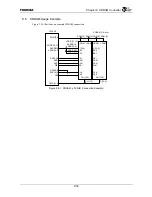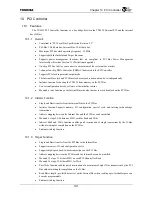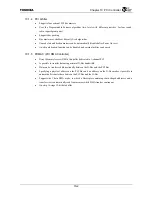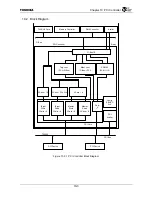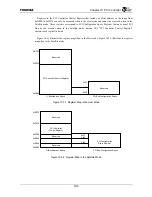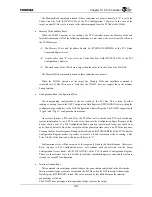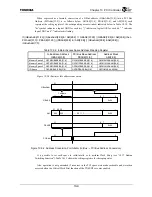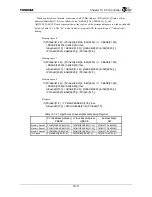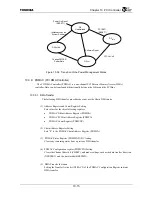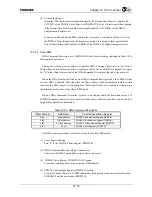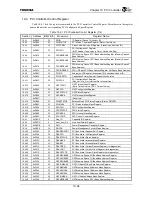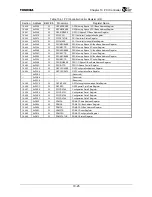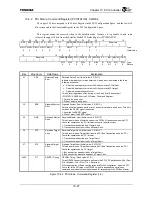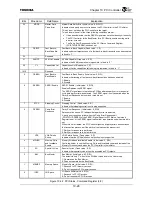
Chapter 10 PCI Controller
10-13
It is possible to set each space to valid/invalid, pre-fetch Read to valid/invalid, or to perform Word
Swap (see 10.3.7). Table 10.3.5 shows the settings registers for these properties.
When pre-fetch Reads are set to valid, data transfer is performed on the G-Bus according to the size
set by the Target Pre-fetch Read Burst Length Field (P2GMnCTR.TPRBL) of the P2G Memory Space n
Control Register during a PCI target Read transaction. This is performed using accesses to resources
that will not be affected even if a pre-read such as memory is performed. Also, PCI Burst Reads to
memory spaces that were set to I/O space and pre-fetch disable are not supported.
Table 10.3.5 Target Access Space Properties Register
Enable
Pre-fetch (Initial State)
Word Swap
Memory Space 0
PCICCFG.TCAR &
MemEnable
&
P2GM0CTR.P2GM0EN
P2GM0CTR.MEM0PD (valid)
P2GM0CTR.BSWAP
Memory Space 1
PCICCFG.TCAR &
MemEnable
&
P2GM1CTR.P2GM1EN
P2GM1CTR.MEM1PD (valid)
P2GM1CTR.BSWAP
Memory Space 2
PCICCFG.TCAR &
MemEnable
&
P2GM2CTR.P2GM2EN
P2GM2CTR.MEM2PD (invalid)
P2GM2CTR.BSWAP
I/O Space
PCICCFG.TCAR &
IOEnable
&
P2GIOCTR.P2GIOEN
Always invalid
P2GIOCTR.BSWAP
MemEnable
:
Host mode:
PCI State Command Register Memory Space bit (PCISTATUS.MEMSP)
Satellite mode: Command Register Memory Space bit
IOEnable
:
Host mode:
PCI State Command Register I/O Space bit (PCISTATUS.IOSP)
Satellite mode: Command Register I/O Space bit
10.3.6 Post
Write
Function
The Post Write function improves system performance by completing the original bus Write
transaction without waiting for the other bus to complete its transaction when the first bus issues a Write
transaction. Initiator Write can Post Write a maximum of four Write transactions, and Target Write can
Post Write a maximum of nine Write transactions.
Due to compatibility issues with old PC software in the PCI specifications, performing Post Writes
with Initiator Configuration Write and Target I/O Write is not recognized. However, the TX4925 PCI
Controller can even perform Post Writes to these functions. In order to guarantee that these Writes are
completed by the target device, please execute Reads to the device that performed the Write, then either
refer to the read value (so the TX49/H2 core can support non-blocking load) or execute the SYNC
instruction.
10.3.7 Endian Switching Function
The TX4925 supports both the Little Endian mode and the Bit Endian mode. On the other hand, the
PCI Bus is only defined in Little Endian logic. Therefore, when the TX4925 is in the Big Endian mode,
either the software or the hardware must perform some kind of conversion when exchanging data larger
than 2 B in size with the PCI Bus.
The PCI Controller can specify the endian switching function that reverses the byte arrangement of
the DWORD (32-bit) data for each access window.
Summary of Contents for TMPR4925
Page 1: ...64 Bit TX System RISC TX49 Family TMPR4925 Rev 3 0 ...
Page 4: ......
Page 15: ...Handling Precautions ...
Page 16: ......
Page 18: ...1 Using Toshiba Semiconductors Safely 1 2 ...
Page 40: ...3 General Safety Precautions and Usage Considerations 3 18 ...
Page 42: ...4 Precautions and Usage Considerations 4 2 ...
Page 43: ...TMPR4925 ...
Page 44: ......
Page 54: ...Chapter 1 Features 1 8 ...
Page 58: ...Chapter 2 Block Diagram 2 4 ...
Page 88: ...Chapter 4 Address Mapping 4 12 ...
Page 226: ...Chapter 8 DMA Controller 8 58 ...
Page 260: ...Chapter 9 SDRAM Controller 9 34 ...
Page 480: ...Chapter 15 Interrupt Controller 15 32 ...
Page 554: ...Chapter 19 Real Time Clock RTC 19 8 ...
Page 555: ...Chapter 20 Removed 20 1 20 Removed ...
Page 556: ...Chapter 20 Removed 20 2 ...
Page 564: ...Chapter 21 Extended EJTAG Interface 21 8 ...
Page 580: ...Chapter 22 Electrical Characteristics 22 16 ...
Page 588: ...Chapter 24 Usage Notes 24 2 ...

